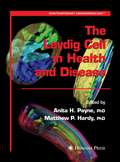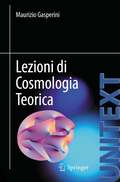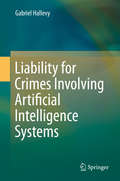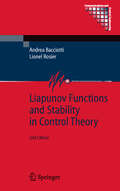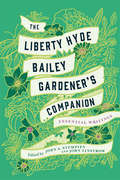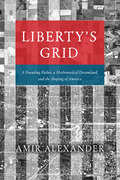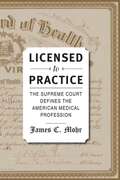- Table View
- List View
The Leydig Cell in Health and Disease (Contemporary Endocrinology)
by Anita H. Payne Matthew P. HardyThis book provides a comprehensive study of the Leydig cell, a fascinating and important cell type. It presents all of the developments in our understanding of Leydig cell biology and explores a wide variety of current and potential clinical applications. All aspects of Leydig cell biology, development, regulation, and physiology are explored in thirty-one expertly written chapters. This in-depth volume is an invaluable resource.
Lezioni di Cosmologia Teorica (UNITEXT)
by Maurizio GasperiniIl libro è basato sulle lezioni attualmente tenute dall'autore presso l’Università di Bari, ed è progettato in modo da rappresentare un testo di riferimento il più possibile moderno, completo e autosufficiente per i corsi semestrale di Cosmologia, Astrofisica o Fisica Astroparticellare che compaiono nel piano di studi della Laurea Magistrale in Fisica e in Astronomia. Contiene gli elementi di base della cosmologia relativistica, del modello cosmologico standard e del suo completamento inflazionario. E' organizzato per servire da traccia ad un corso di cosmologia di stampo teorico, ma cerca di non perdere mai di vista il confronto con i principali risultati osservativi: molta attenzione viene infatti dedicata alla fenomenologia dei fondi cosmici, e in particolare alla radiazione gravitazionale fossile perchè la sua rivelazione, diretta o indiretta, potrebbe dare indicazioni cruciali sulla scelta del corretto modello per l'Universo primordiale. Non mancano infine alcuni accenni ad argomenti di interesse emergente, di tipo teorico-fenomenologico, come lo studio dell'effetto di "deriva" del redshift, la cosmologia delle membrane, e il problema delle medie cosmologiche fatte su ipersuperfici spaziali (o nulle) non omogenee.
The LGM Distribution of Dominant Tree Genera in Northern China's Forest-steppe Ecotone and Their Postglacial Migration (Springer Theses)
by Qian HaoThis book systematically discusses the vegetation dynamics in northern China since the LGM, with a focus on three dominant tree species (Pinus, Quercus and Betula). By integrating methods of palaeoecology, phylogeography and species distribution model, it reconstructs the glacial refugia in northern China, demonstrating that the species were located further north than previously assumed during the LGM. The postglacial dynamics of forest distribution included not only long-distance north-south migration but also local spread from LGM micro-refugia in northern China. On the regional scale, the book shows the altitudinal migration pattern of the three dominant tree genera and the role of topographical factors in the migration of the forest-steppe border. On the catchment scale, it analyzes Huangqihai Lake, located in the forest-steppe ecotone in northern China, to indentify the local forest dynamics response to the Holocene climatic change. It shows that local forests have various modes of response to the climate drying, including shrubland expansion, savannification and replacement of steppe. In brief, these studies at different space-time scales illustrate the effects of climate, topography and other factors on forest migration.
LHC Phenomenology (Scottish Graduate Series)
by Einan Gardi Nigel Glover Aidan RobsonThis book covers a very broad spectrum of experimental and theoretical activity in particle physics, from the searches for the Higgs boson and physics beyond the Standard Model, to detailed studies of Quantum Chromodynamics, the B-physics sectors and the properties of hadronic matter at high energy density as realised in heavy-ion collisions.Starting with a basic introduction to the Standard Model and its most likely extensions, the opening section of the book presents an overview of the theoretical and phenomenological framework of hadron collisions and current theoretical models of frontier physics. In part II, discussion of the theory is supplemented by chapters on the detector capabilities and search strategies, as well as an overview of the main detector components, the initial calibration procedures and physics samples and early LHC results. Part III completes the volume with a description of the physics behind Monte Carlo event generators and a broad introduction to the main statistical methods used in high energy physics.LHC Phenomenology covers all of these topics at a pedagogical level, with the aim of providing young particle physicists with the basic tools required for future work on the various LHC experiments. It will also serve as a useful reference text for those working in the field.
Li-S and Li-O2 Batteries with High Specific Energy: Research and Development (SpringerBriefs in Molecular Science)
by Huamin Zhang Xianfeng Li Hongzhang ZhangThis brief reviews the fundamentals, recent developments, challenges and prospects of Li-S and Li-O2 batteries, including fundamental research and potential applications. It starts with a brief overview encompassing the current state of Li-S and Li-O2 battery technology. It then provides general information on Li-S and Li-O2 batteries, including the electrochemical processes and battery components. The following sections focus on the historical and recent development of Li-S and Li-O2 batteries respectively, offering detailed insights into the key material development, cell assembly, diagnostic test and mechanism of electrolyte decomposition. Lastly, it focuses on the main promising applications of Li-S and Li-O2 batteries together with their challenges and potential
Liability for Crimes Involving Artificial Intelligence Systems
by Gabriel HallevyThe book develops a general legal theory concerning the liability for offenses involving artificial intelligence systems. The involvement of the artificial intelligence systems in these offenses may be as perpetrators, accomplices or mere instruments. The general legal theory proposed in this book is based on the current criminal law in most modern legal systems.In most modern countries, unmanned vehicles, sophisticated surgical systems, industrial computing systems, trading algorithms and other artificial intelligence systems are commonly used for both industrial and personal purposes. The question of legal liability arises when something goes wrong, e.g. the unmanned vehicle is involved in a car accident, the surgical system is involved in a surgical error or the trading algorithm is involved in fraud, etc. Who is to be held liable for these offenses: the manufacturer, the programmer, the user, or, perhaps, the artificial intelligence system itself?The concept of liability for crimes involving artificial intelligence systems has not yet been widely researched. Advanced technologies are forcing society to face new challenges, both technical and legal. The idea of liability in the specific context of artificial intelligence systems is one such challenge that should be thoroughly explored.
Liapunov Functions and Stability in Control Theory (Communications and Control Engineering)
by Andrea Bacciotti Lionel RosierThis book presents a modern and self-contained treatment of the Liapunov method for stability analysis, in the framework of mathematical nonlinear control theory. A Particular focus is on the problem of the existence of Liapunov functions (converse Liapunov theorems) and their regularity, whose interest is especially motivated by applications to automatic control. Many recent results in this area have been collected and presented in a systematic way. Some of them are given in extended, unified versions and with new, simpler proofs. In the 2nd edition of this successful book several new sections were added and old sections have been improved, e.g., about the Zubovs method, Liapunov functions for discontinuous systems and cascaded systems. Many new examples, explanations and figures were added making this book accessible and well readable for engineers as well as mathematicians.
The Liars of Nature and the Nature of Liars: Cheating and Deception in the Living World
by Lixing SunA natural history of cheating from selfish genes to lying politiciansNature is rife with cheating. Possums play possum, feigning death to cheat predators. Crows cry wolf to scare off rivals. Amphibians and reptiles are inveterate impostors. Even genes and cells cheat. The Liars of Nature and the Nature of Liars explores the evolution of cheating in the natural world, revealing how dishonesty has given rise to wondrous diversity.Blending cutting-edge science with a wealth of illuminating examples—from microscopic organisms to highly intelligent birds and mammals—Lixing Sun shows how cheating in nature relies on two basic rules. One is lying, by which cheaters exploit honest messages in communication signals and use them to serve their own interests. The other is deceiving, by which cheaters exploit the biases and loopholes in the sensory systems of other creatures. Sun demonstrates that cheating serves as a potent catalyst in the evolutionary arms race between the cheating and the cheated, resulting in a biological world teeming with complexity and beauty.Brimming with insight and humor, The Liars of Nature and the Nature of Liars also looks at the prevalence of cheating in human society, identifying the kinds of cheating that spur innovation and cultural vitality and laying down a blueprint for combatting malicious cheating such as fake news and disinformation.
Liberal Protestantism and Science (Greenwood Guides to Science and Religion)
by Leslie A. MurayMany students and members of the public who follow news reports on science and religion may think that Protestantism and science are in conflict. But while evangelical attacks on evolution may make the headlines, many mainstream Protestant groups have long embraced science and the scientific worldview. This volume in the Greenwood Guides to Science and Religion covers those Protestant thinkers who seek to use the insights of science to further their understanding of religion and faith. In addition, the volume will also discuss such trends at the liberal protestant acceptance of evolution, the advent of ecotheology, and the Social Gospel.The volume includes a selection of primary source documents, a glossary and a timeline, and an annotated bibliography of the most useful resources for further research.
Liberating Energy from Carbon: Introduction To Decarbonization (Lecture Notes in Energy #22)
by Nazim MuradovLiberating Energy from Carbon analyzes energy options in a carbon-constrained world. Major strategies and pathways to decarbonizing the carbon-intensive economy are laid out with a special emphasis on the prospects of achieving low-risk atmospheric CO2 levels. The opportunities and challenges in developing and bringing to market novel low and zero-carbon technologies are highlighted from technical, economic and environmental viewpoints. This book takes a unique approach by treating carbon in a holistic manner—tracking its complete transformation chain from fossil fuel sources to the unique properties of the CO2 molecule, to carbon capture and storage and finally, to CO2 industrial utilization and its conversion to value-added products and fuels. This concise but comprehensive sourcebook guides readers through recent scientific and technological developments as well as commercial projects that aim for the decarbonization of the fossil fuel-based economy and CO2 utilization that will play an increasingly important role in the near- and mid-term future. This book is intended for researchers, engineers, and students working and studying in practically all areas of energy technology and alternative energy sources and fuels.
Liberating Science: The Early Universe, Evolution, and the Public Voice of Science
by Prof Andrew SteaneLiberating Science: The Early Universe, Evolution and the Public Voice of Science is a presentation of science for the general reader, with an emphasis on correcting widely held misconceptions, and a call to liberate science from 'private ownership' in cultural terms. Quantum fields and the physics of the early universe are described in non-technical language, showing what science can and cannot say about origins. Darwinian evolution is then discussed, giving due weight both to variation and to the constraints which shape the possible outcomes.The text provides a liberating view of what science is telling us about the natural world and offers the next generation a balanced and liberating view of their own moral stature.
Liberty and the Ecological Crisis: Freedom on a Finite Planet (Routledge Explorations in Environmental Studies)
by Katie Kish Christopher Orr Bruce JenningsThis book examines the concept of liberty in relation to civilization&’s ability to live within ecological limits. Freedom, in all its renditions – choice, thought, action – has become inextricably linked to our understanding of what it means to be modern citizens. And yet, it is our relatively unbounded freedom that has resulted in so much ecological devastation. Liberty has piggy-backed on transformations in human-nature relationships that characterize the Anthropocene: increasing extraction of resources, industrialization, technological development, ecological destruction, and mass production linked to global consumerism. This volume provides a deeply critical examination of the concept of liberty as it relates to environmental politics and ethics in the long view. Contributions explore this entanglement of freedom and the ecological crisis as well as investigate alternative modernities and more ecologically benign ways of living on Earth. The overarching framework for this collection is that liberty and agency need to be rethought before these strongly held ideals of our age are forced out. On a finite planet, our choices will become limited if we hope to survive the climatic transitions set in motion by uncontrolled consumption of resources and energy over the past one hundred and fifty years. This volume suggests concrete political and philosophical approaches and governance strategies for learning how to flourish in new ways within the ecological constraints of the planet. Mapping out new ways forward for long term ecological well-being, this book is essential reading for students and scholars of ecology, environmental ethics, politics and sociology and for the wider audience interested in the human-earth relationship and global sustainability.
Liberty and the Ecological Crisis: Freedom on a Finite Planet (Routledge Explorations in Environmental Studies #1)
by Christopher J. Orr Kaitlin Kish Bruce JenningsThis book examines the concept of liberty in relation to civilization&’s ability to live within ecological limits. Freedom, in all its renditions – choice, thought, action – has become inextricably linked to our understanding of what it means to be modern citizens. And yet, it is our relatively unbounded freedom that has resulted in so much ecological devastation. Liberty has piggy-backed on transformations in human-nature relationships that characterize the Anthropocene: increasing extraction of resources, industrialization, technological development, ecological destruction, and mass production linked to global consumerism. This volume provides a deeply critical examination of the concept of liberty as it relates to environmental politics and ethics in the long view. Contributions explore this entanglement of freedom and the ecological crisis as well as investigate alternative modernities and more ecologically benign ways of living on Earth. The overarching framework for this collection is that liberty and agency need to be rethought before these strongly held ideals of our age are forced out. On a finite planet, our choices will become limited if we hope to survive the climatic transitions set in motion by uncontrolled consumption of resources and energy over the past one hundred and fifty years. This volume suggests concrete political and philosophical approaches and governance strategies for learning how to flourish in new ways within the ecological constraints of the planet. Mapping out new ways forward for long term ecological well-being, this book is essential reading for students and scholars of ecology, environmental ethics, politics and sociology and for the wider audience interested in the human-earth relationship and global sustainability.
Liberty Bell 7: The Suborbital Mercury Flight of Virgil I. Grissom (Springer Praxis Books)
by Colin BurgessNASA’s Mercury astronauts were seven highly skilled professional test pilots. Each of them seemed to possess the strength of character and commitment necessary to overcome apparently insurmountable obstacles as the United States entered into a Cold War space race with the Soviet Union. This was never more evident than on the epic suborbital MR-4 flight of Liberty Bell 7 with astronaut Virgil (‘Gus’) Grissom piloting the spacecraft to a successful splashdown, followed by the premature blowing of the craft’s explosive hatch. After a hurried exit and struggling to stay afloat, he could only watch helplessly as the recovery helicopter pilot valiantly fought a losing battle to save the sinking capsule. That day NASA not only lost a spacecraft but came perilously close to losing one of its Mercury astronauts, a decorated Korean fighter pilot from Indiana who might one day have soared to the highest goal of them all, as the first person to set foot on the Moon. For the first time, many of those closest to the flight of Liberty Bell 7 and astronaut Gus Grissom offer their stories and opinions on the dramatic events of July 21, 1961, and his later pioneering Gemini mission. They also tell of an often controversial life cut tragically and horrifically short in a launch pad fire that shocked the nation.
The Liberty Hyde Bailey Gardener's Companion: Essential Writings
by Liberty Hyde Bailey"Every family can have a garden." -Liberty Hyde BaileyFinally, the best and most accessible garden writings of perhaps the most influential literary gardener of the twentieth century have been brought together in one book. Philosopher, poet, naturist, educator, agrarian, scientist, and garden-lover par excellence Liberty Hyde Bailey built a reputation as the Father of Modern Horticulture and evangelist for what he called the "garden-sentiment"—the desire to raise plants from the good earth for the sheer joy of it and for the love of the plants themselves. Bailey's perennial call to all of us to get outside and get our hands dirty, old or young, green thumb or no, is just as fresh and stirring today as then.Full of timeless wit and grace, The Liberty Hyde Bailey Gardener's Companion collects essays and poems from Bailey's many books on gardening, as well as from newspapers and magazines from the era. Whether you've been gardening for decades or are searching for your first inspiration, Bailey's words will make an ideal companion on your journey.
The Liberty to Take Fish: Atlantic Fisheries and Federal Power in Nineteenth-Century America
by Thomas Blake EarleIn The Liberty to Take Fish, Thomas Blake Earle offers an incisive and nuanced history of the long American Revolution, describing how aspirations to political freedom coupled with the economic imperatives of commercial fishing roiled relations between the young United States and powerful Great Britain. The American Revolution left the United States with the "liberty to take fish" from the waters of the North Atlantic. Indispensable to the economic health of the new nation, the cod fisheries of the Grand Banks, the Bay of Fundy, and the Gulf of St. Lawrence quickly became symbols of American independence in an Atlantic world dominated by Great Britain. The fisheries issue was a near-constant concern in American statecraft that impinged upon everything, from Anglo-American relations, to the operation of American federalism, and even to the nature of the marine environment. Earle explores the relationship between the fisheries and the state through the Civil War era when closer ties between the United States and Great Britain finally surpassed the contentious interests of the fishing industry on the nation's agenda.The Liberty to Take Fish is a rich story that moves from the staterooms of Washington and London to the decks of fishing schooners and into the Atlantic itself to understand how ordinary fishermen and the fish they pursued shaped and were, in turn, shaped by those far-off political and economic forces. Earle returns fishing to its once-central place in American history and shows that the nation of the nineteenth century was indeed a maritime one.
Liberty's Grid: A Founding Father, a Mathematical Dreamland, and the Shaping of America
by Amir AlexanderThe surprising history behind a ubiquitous facet of the United States: the gridded landscape. Seen from an airplane, much of the United States appears to be a gridded land of startling uniformity. Perpendicular streets and rectangular fields, all precisely measured and perfectly aligned, turn both urban and rural America into a checkerboard landscape that stretches from horizon to horizon. In evidence throughout the country, but especially the West, the pattern is a hallmark of American life. One might consider it an administrative convenience—an easy way to divide land and lay down streets—but it is not. The colossal grid carved into the North American continent, argues historian and writer Amir Alexander, is a plan redolent with philosophical and political meaning. In 1784 Thomas Jefferson presented Congress with an audacious scheme to reshape the territory of the young United States. All western lands, he proposed, would be inscribed with a single rectilinear grid, transforming the natural landscape into a mathematical one. Following Isaac Newton and John Locke, he viewed mathematical space as a blank slate on which anything is possible and where new Americans, acting freely, could find liberty. And if the real America, with its diverse landscapes and rich human history, did not match his vision, then it must be made to match it. From the halls of Congress to the open prairies, and from the fight against George III to the Trail of Tears, Liberty’s Grid tells the story of the battle between grid makers and their opponents. When Congress endorsed Jefferson’s plan, it set off a struggle over American space that has not subsided. Transcendentalists, urban reformers, and conservationists saw the grid not as a place of possibility but as an artificial imposition that crushed the human spirit. Today, the ideas Jefferson associated with the grid still echo through political rhetoric about the country’s founding, and competing visions for the nation are visible from Manhattan avenues and Kansan pastures to Yosemite’s cliffs and suburbia’s cul-de-sacs. An engrossing read, Liberty’s Grid offers a powerful look at the ideological conflict written on the landscape.
Liberty's Grid: A Founding Father, a Mathematical Dreamland, and the Shaping of America
by Amir AlexanderThe surprising history behind a ubiquitous facet of the United States: the gridded landscape. Seen from an airplane, much of the United States appears to be a gridded land of startling uniformity. Perpendicular streets and rectangular fields, all precisely measured and perfectly aligned, turn both urban and rural America into a checkerboard landscape that stretches from horizon to horizon. In evidence throughout the country, but especially the West, the pattern is a hallmark of American life. One might consider it an administrative convenience—an easy way to divide land and lay down streets—but it is not. The colossal grid carved into the North American continent, argues historian and writer Amir Alexander, is a plan redolent with philosophical and political meaning. In 1784 Thomas Jefferson presented Congress with an audacious scheme to reshape the territory of the young United States. All western lands, he proposed, would be inscribed with a single rectilinear grid, transforming the natural landscape into a mathematical one. Following Isaac Newton and John Locke, he viewed mathematical space as a blank slate on which anything is possible and where new Americans, acting freely, could find liberty. And if the real America, with its diverse landscapes and rich human history, did not match his vision, then it must be made to match it. From the halls of Congress to the open prairies, and from the fight against George III to the Trail of Tears, Liberty’s Grid tells the story of the battle between grid makers and their opponents. When Congress endorsed Jefferson’s plan, it set off a struggle over American space that has not subsided. Transcendentalists, urban reformers, and conservationists saw the grid not as a place of possibility but as an artificial imposition that crushed the human spirit. Today, the ideas Jefferson associated with the grid still echo through political rhetoric about the country’s founding, and competing visions for the nation are visible from Manhattan avenues and Kansan pastures to Yosemite’s cliffs and suburbia’s cul-de-sacs. An engrossing read, Liberty’s Grid offers a powerful look at the ideological conflict written on the landscape.
Licensed to Practice: The Supreme Court Defines the American Medical Profession
by James C. MohrLicensed to Practice begins with an 1891 shooting in Wheeling, West Virginia, that left one doctor dead and another on trial for his life. Formerly close friends, the doctors had fallen out over the issue of medical licensing. Historian James C. Mohr calls the murder "a sorry personal consequence of the far larger and historically significant battle among West Virginia’s physicians over the future of their profession."Through most of the nineteenth century, anyone could call themselves a doctor and could practice medicine on whatever basis they wished. But an 1889 U.S. Supreme Court case, Dent v. West Virginia, effectively transformed medical practice from an unregulated occupation to a legally recognized profession. The political and legal battles that led up to the decision were unusually bitter—especially among physicians themselves—and the outcome was far from a foregone conclusion.So-called Regular physicians wanted to impose their own standards on the wide-open medical marketplace in which they and such non-Regulars as Thomsonians, Botanics, Hydropaths, Homeopaths, and Eclectics competed. The Regulars achieved their goal by persuading the state legislature to make it a crime for anyone to practice without a license from the Board of Health, which they controlled. When the high court approved that arrangement—despite constitutional challenges—the licensing precedents established in West Virginia became the bedrock on which the modern American medical structure was built. And those precedents would have profound implications. Thus does Dent, a little-known Supreme Court case, influence how Americans receive health care more than a hundred years after the fact.
Licensed to Practice: The Supreme Court Defines the American Medical Profession
by James C. MohrLicensed to Practice begins with an 1891 shooting in Wheeling, West Virginia, that left one doctor dead and another on trial for his life. Formerly close friends, the doctors had fallen out over the issue of medical licensing. Historian James C. Mohr calls the murder "a sorry personal consequence of the far larger and historically significant battle among West Virginia’s physicians over the future of their profession."Through most of the nineteenth century, anyone could call themselves a doctor and could practice medicine on whatever basis they wished. But an 1889 U.S. Supreme Court case, Dent v. West Virginia, effectively transformed medical practice from an unregulated occupation to a legally recognized profession. The political and legal battles that led up to the decision were unusually bitter—especially among physicians themselves—and the outcome was far from a foregone conclusion.So-called Regular physicians wanted to impose their own standards on the wide-open medical marketplace in which they and such non-Regulars as Thomsonians, Botanics, Hydropaths, Homeopaths, and Eclectics competed. The Regulars achieved their goal by persuading the state legislature to make it a crime for anyone to practice without a license from the Board of Health, which they controlled. When the high court approved that arrangement—despite constitutional challenges—the licensing precedents established in West Virginia became the bedrock on which the modern American medical structure was built. And those precedents would have profound implications. Thus does Dent, a little-known Supreme Court case, influence how Americans receive health care more than a hundred years after the fact.
Lichen-Derived Products: Extraction and Applications
by Mohd YusufThe purpose of this book is to provide reference material that includes current developments along with a future outlook on the topic. It is divided into two sections; “Morphological Overview and Extraction Prospects” and “Trends and Applications”. Part I contains four chapters that provide an overview and systematically discuss the physical morphology, suitability and extraction aspects of lichens and their secondary metabolites. Part II includes eight chapters that give in-depth insights on recent and valuable applications of lichen and their obtained products in several applied sectors, including ethnopharmacology, therapeutics, paper and dye, nutraceuticals, cosmetics, herbal industries, etc.
Lichen-Derived Products: Extraction and Applications
by Mohd YusufThe purpose of this book is to provide reference material that includes current developments along with a future outlook on the topic. It is divided into two sections; “Morphological Overview and Extraction Prospects” and “Trends and Applications”. Part I contains four chapters that provide an overview and systematically discuss the physical morphology, suitability and extraction aspects of lichens and their secondary metabolites. Part II includes eight chapters that give in-depth insights on recent and valuable applications of lichen and their obtained products in several applied sectors, including ethnopharmacology, therapeutics, paper and dye, nutraceuticals, cosmetics, herbal industries, etc.
Lichen Secondary Metabolites: Bioactive Properties and Pharmaceutical Potential
by Branislav RankovićThe present book discusses in detail the nature and bioactive properties of lichen secondary metabolites. Their therapeutic potential ranges from antibiotic to antioxidant and from anticarcinogenic to antiviral activity. It further discusses their use in traditional medicine and highlights possible future directions in the study of their pharmaceutical potential.
Lichen Secondary Metabolites: Bioactive Properties and Pharmaceutical Potential
by Branislav RankovićThis revised and extended edition provides in-depth insights into the benefits and untapped potential of lichen-derived bioactive compounds. The whole spectrum of these compounds’ biological and medical functions, from antibiotic to antiviral and anti-carcinogenic properties, is presented. In addition, a new chapter discusses the anti-neurodegenerative and anti-diabetic activities of lichenic secondary metabolites. Given its scope, the book offers a valuable asset for students and researchers in this field.

